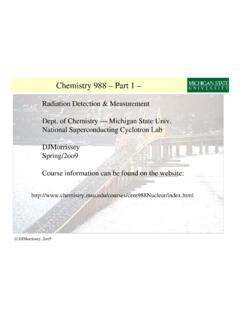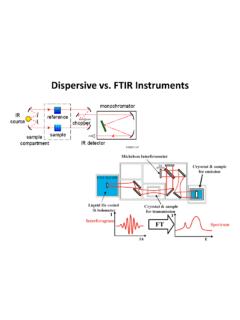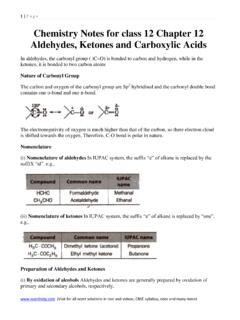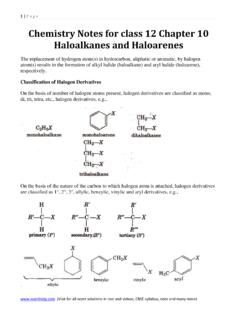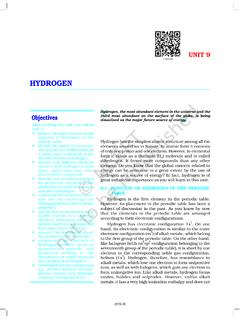Transcription of Chapter 22 – Introduction to Electroanalytical Chemistry
1 Chapter 22 Introduction to Electroanalytical Chemistry Electroanalytical methods are a class of techniques in analytical Chemistry , which study an analyte by measuring the potential (volts) and/or current (amperes) in an electrochemical cell containing the analyte. The three main categories are potentiometry (the difference in electrode potentials is measured), coulometry (the cell's current is measured over time), and voltammetry (the cell's current is measured while actively altering the cell's potential). Read: pp. 628-653 Problems: 2,3,8,9 Electroanalytical Measurements Electrochemical (analytical measurements) are heterogeneous in nature.
2 Electrode Electrolyte solution Ox Red e- Important factors: electrode material, electrolyte solution, surface cleanliness, and surface Chemistry kCi Current is also a direct measure of reaction rate. Potentiometric Measurements V Reference Electrode Indicator Electrode Ox Ox Ox Ox ]log[ ).(OxzLrefvsEind No current flow!! Equilibrium potential measurement!! Examples: pH measurement, ion selective electrodes, gas sensing electrodes Potentiometry passively measures the potential of a solution between two electrodes, affecting the solution very little in the process.
3 The potential is then related to the concentration of one or more analytes. Voltammetric Measurements Counter Electrode Working Electrode Ox + e- Red i Ox Red kCi Voltammetry applies a constant and/or varying potential at an electrode's surface and measures the resulting current with a three electrode system. This method can reveal the reduction potential of an analyte and its electrochemical reactivity. This method in practical terms is nondestructive since only a very small amount of the analyte is consumed at the two-dimensional surface of the working and counter electrodes.
4 Electrochemical Sensors for Clinical Analysis Various electrochemical sensors can be used to measure important analytes in blood. They tend to be inexpensive, robust, sensitive and selective with the proper surface modification. Sensors 8 (2008) 2043-2081 Electrochemical Cells Electrochemical cells consist of two electrodes: an anode (the electrode at which the oxidation reaction occurs) and a cathode (the electrode at which the reduction reaction occurs). Cu(s) + Zn+2 Cu+2 + Zn(s) Cu(s) Cu+2 + 2e- (oxidation) Zn+2 + 2e- Zn(s) (reduction) There are two types of electrochemical cells: galvanic (ones that spontaneously produce electrical energy) and electrolytic (ones that consume electrical energy).
5 Electrochemical Cells A potential difference between two electrodes represents a tendency for the reaction to occur! Conduction (ion migration) rxns (at interfaces) Electrochemical Potentials The potential that develops in a cell is a measure of the tendency for a reaction to proceed toward equilibrium. E = Eo + RT nF log [Ox] [Red] Nernst Equation ax = [x] Standard reduction reactions: all relative to the H2/H+ reaction, 298 K, unit activities for all species, and pH 0. Measured E vs. Ref Electrochemical Potentials We use concentrations in the Nernst equation, but really activities are the proper term.
6 The activity of a species can be defined as the ability of a species to participate an equilibrium reaction involving itself. Fe+3 + e- Fe+2 FeCl+2, etc. Depends on ionic strength Ecell = Ecathode Eanode Grxn = - nFEcell Grxn = -RTlnKeq Key equations Reference Electrodes (s) + e- Ag(s) + Cl- E = Eo + ( )log1/[Cl-] (s) + 2e- 2Cl- + 2Hg(l) E = Eo + ( )log1/[Cl-]2 All cell potential measurements require two electrodes! n = number of electrons transferred per mole, RT/F = V Electrochemical Cells Cu+2 + H2(g) Cu(s) + 2H+ Zn/ZnSO4 (aZn+2 = )//CuSO4 (aCu+2 = )/Cu Anode (oxidation) Cathode (reduction) This shorthand is not always used in your textbook.
7 Electrochemical Cells and Reactions solid solution Electrode (conductor) Electrolyte (ionic solution) Electrodes: Pt, Au, Pd, C, Hg Electrolyte solutions (low ohmic resistance): ionic solutions (NaCl), molten salts, and ionic polymers (Nafion). Electrode Solution Ox Red e- Ox + e- Red Electrode reaction kinetics are affected by the electrode surface cleanliness, surface microstructure, and surface Chemistry . Junction Potentials Potentials develop anytime there is charge separation! Ions move in the presence of an electric field.
8 1:1 electrolytes are normally homogeneous in a solution and there is no charge separation. Differences in ion mobility give rise to junction potentials. Unequal distribution! Ecell = Ecathode Eanode + Ej Equilbrium vs. Non-equilibrium Electrochemical Measurements Potentiometric = (0 net current measurements, stable potential that reflects activity of a reactant near the electrode surface.) Voltammetric = (a current flows in response to an applied potential.) When currents flow, net reactions take place. Since there are two electrodes (a working and a counter electrode), an oxidation reaction occurs at the anode and a reduction reaction occurs at the cathode.
9 Current (A=coulomb/sec) is a direct measure of the rxn. rate! Currents in Electrochemical Cells When currents are allowed to flow in electrochemical cells, this means that net reactions are taking place at each electrode. Equilibrium concentrations, as dictated by the Nernst equation are not necessarily achieved on the time-scale of the voltammetric measurement. E = iR where R is the resistance in the cell. Some types of resistance that can limit the current flow are charge-transfer resistance, mass transport resistance and solution ohmic resistance.
10 Ecell = Ecathode Eanode iR i kC where C is the analyte concentration Currents in Electrochemical Cells Remember = all electrochemical reactions take place at the electrode-solution interface!! Modes of mass transport: (i) diffusion, (ii) convection and (iii) migration. i (current) = Q/ t = nFA(area, cm2) C/ t (flux, mol/s-cm2) Current limited by (i) charge transfer resistance, (ii) mass transport resistance and ohmic solution resistance.



